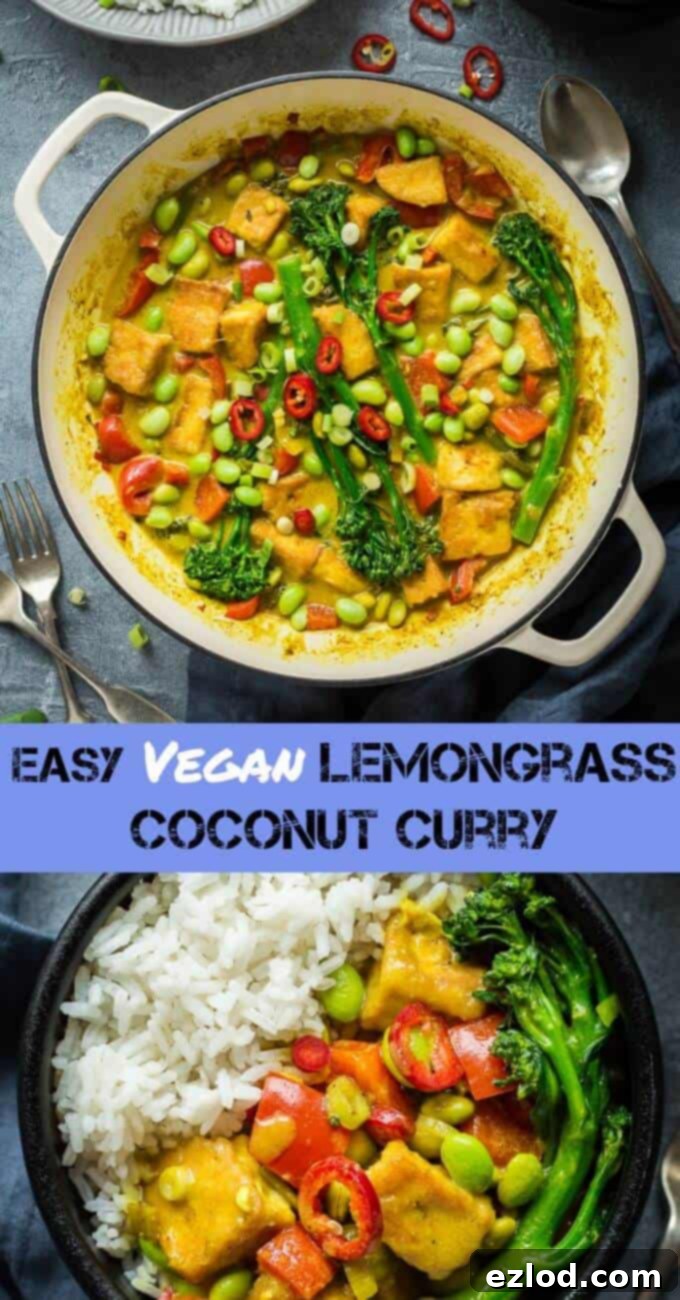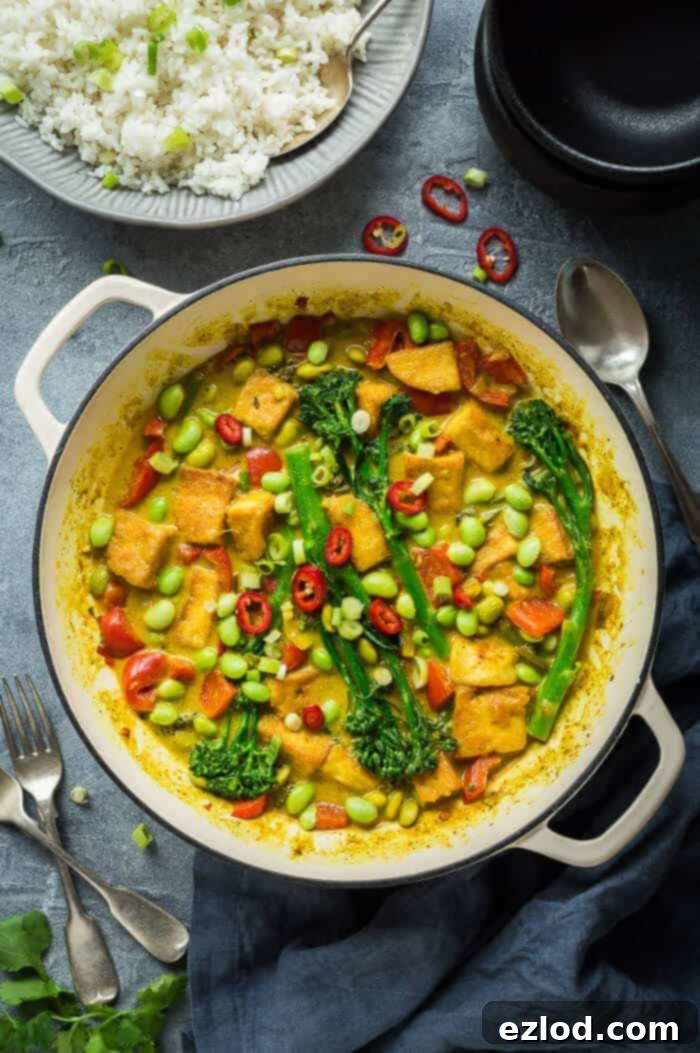Effortless Vegan Lemongrass Coconut Curry: A Quick, Healthy & High-Protein Weeknight Delight
Discover the joy of cooking with this easy lemongrass and coconut curry – a truly delicious vegan, vegetable, and tofu curry that’s incredibly quick to prepare and bursting with vibrant flavours. More than just a meal, it’s a healthy, high-protein, and satisfying plant-based option perfect for any night of the week.
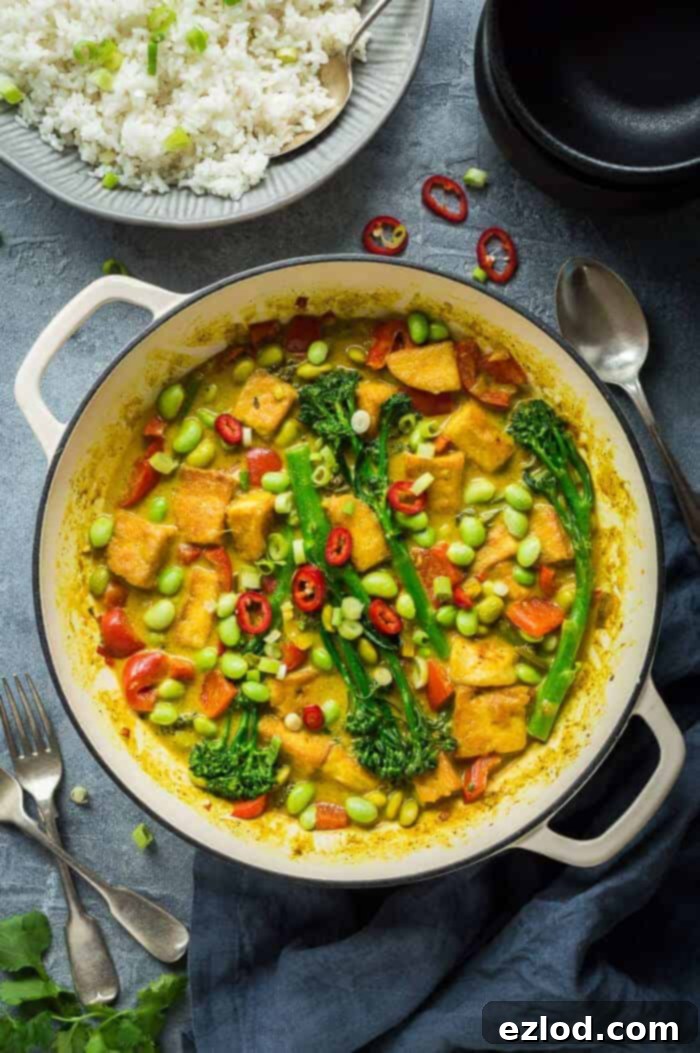
There’s a reason this easy vegan lemongrass and coconut curry has become a firm favourite in my kitchen. It consistently delivers on taste, health, and convenience, making it an ideal choice for busy weeknights. Imagine a velvety, subtly spiced, and wonderfully aromatic coconut and lemongrass sauce, generously loaded with an assortment of fresh vegetables and hearty tofu. Served over a bed of steamy rice, it transforms into a comforting and utterly satisfying meal that feels gourmet without the fuss.
My goal with this recipe was to create something truly achievable, even when time is tight. That’s why I embrace a few clever shortcuts to streamline the cooking process. Instead of finely mincing fresh lemongrass and ginger, I opt for ready-made pastes from a jar. These flavourful pastes offer all the aromatic goodness without the extra prep work. For an even quicker start, you can extend this convenience to garlic and chilli too, using jarred versions to bypass chopping and peeling entirely.
These small adjustments significantly cut down on the time typically spent on mise en place, making this vibrant curry a realistic and appealing option for a speedy weeknight dinner. Most well-stocked supermarkets now carry a range of pre-prepared lemongrass, ginger, garlic, and chilli pastes, usually found alongside the spices. Keeping these essentials stocked in your fridge means you’re always just a few steps away from whipping up incredibly flavourful and quick meals like this one.
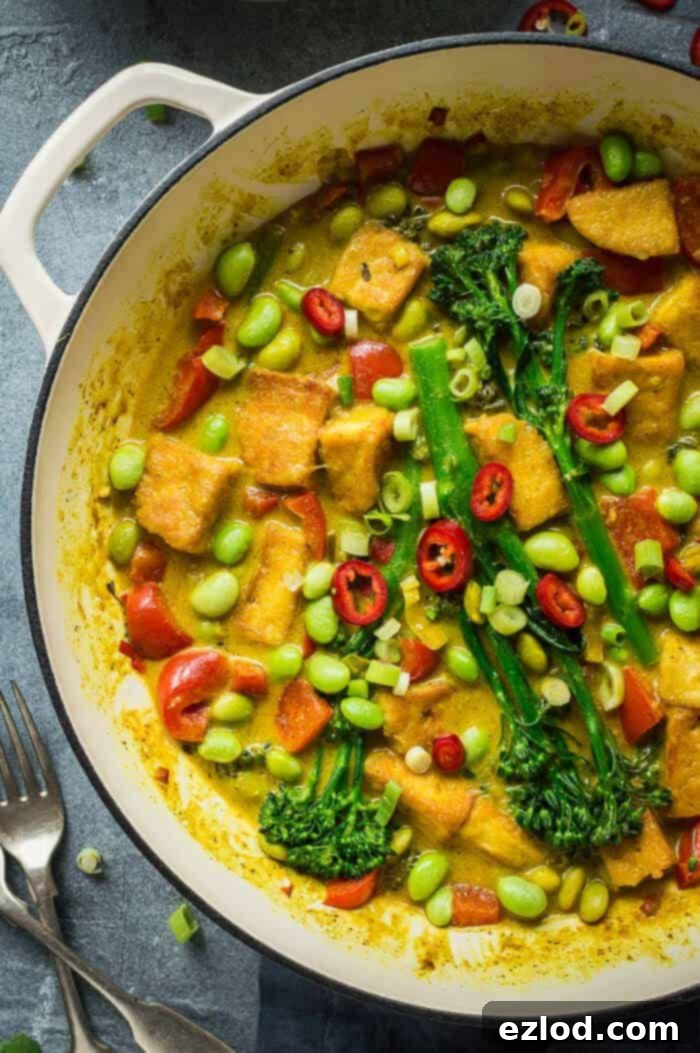
Crafting a High-Protein Vegan Masterpiece
When it comes to plant-based meals, ensuring adequate protein intake is often a key consideration. This lemongrass coconut curry excels in this regard, offering a substantial protein boost from multiple sources. Our primary protein hero is, of course, firm tofu – a classic and versatile choice in vegan cuisine known for its ability to absorb flavours beautifully. Tofu provides a fantastic base, but we don’t stop there.
I also incorporate frozen edamame (young soybeans), which are an absolute nutritional powerhouse. Ounce for ounce, edamame surprisingly contains even more protein than tofu, packing a significant punch into every serving. What makes both tofu and edamame particularly valuable is that they are both sources of complete protein. This means they contain all nine essential amino acids that our bodies cannot produce on their own, making them incredibly efficient and beneficial for muscle repair, growth, and overall bodily function.
To round out the protein profile and add an extra layer of texture and nutrition, I include tenderstem broccoli. I confess, I could happily eat tenderstem broccoli every single day! It’s not just delicious and visually appealing; it’s also remarkably healthy and, perhaps surprisingly, one of the higher-protein vegetables available. Its slightly sweet flavour and tender-crisp texture integrate perfectly into the creamy curry sauce, contributing essential vitamins, minerals, and fibre alongside its protein content. Together, these ingredients create a meal that is not only satisfying and flavourful but also robustly nutritious.
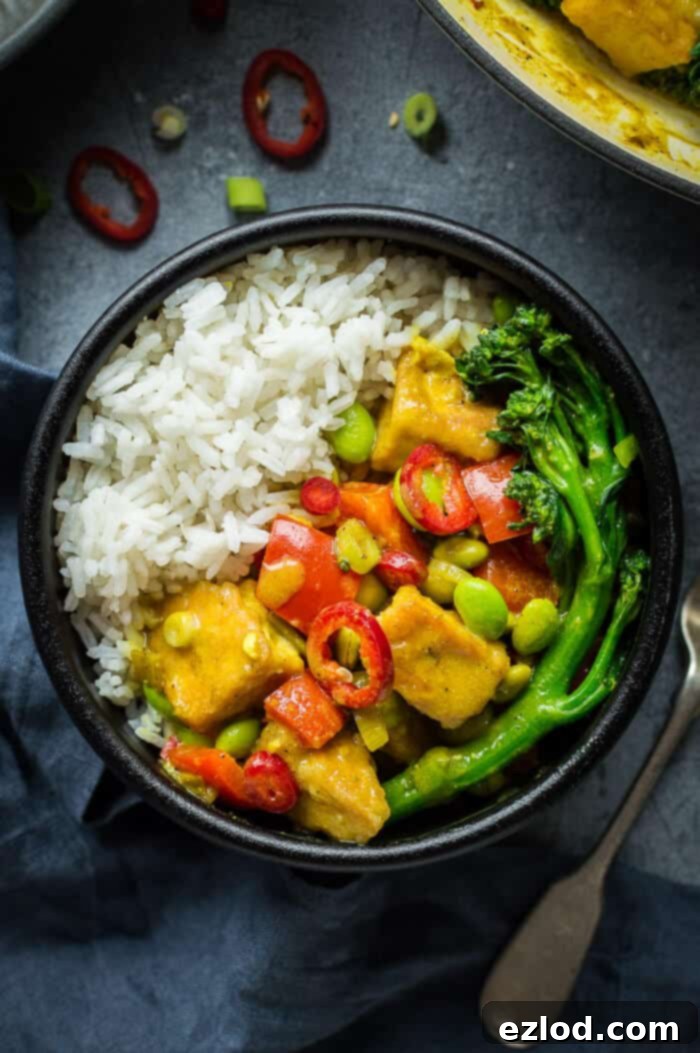
How To Make Easy Vegan Lemongrass and Coconut Curry: A Step-by-Step Guide
Creating this aromatic and flavourful vegan curry is simpler than you might think, especially with our smart shortcuts. Here’s a narrative walkthrough of the process, offering tips to ensure your curry turns out perfect every time. For precise measurements and a detailed step-by-step list, please refer to the recipe card below.
Building the Flavour Base
Begin by heating a tablespoon of olive oil in a large pan or wok over medium heat. Add the crushed fresh garlic (or a teaspoon of garlic paste for convenience), thinly sliced spring onions, colourful red bell pepper, and finely chopped red chilli (or a teaspoon of chilli paste). Sauté these aromatic vegetables gently for about five minutes. The goal here is to soften them and allow their flavours to meld without browning too much. This initial step builds a foundational layer of taste for your curry. If you opt for jarred garlic and chilli pastes, hold off on adding them until the next stage to prevent them from burning.
Once your vegetables are softened and fragrant, it’s time to introduce the heart of the curry’s flavour. Stir in the lemongrass and ginger pastes (this is also when you’d add your jarred garlic and chilli if using them). Follow with two teaspoons of fragrant garam masala and one teaspoon of vibrant turmeric. Continue to fry for just one minute, stirring constantly. This brief toasting of the spices in the hot oil helps to release their full aroma and deepen their flavour, creating an incredibly fragrant base that will infuse the entire curry.
Creating the Creamy Coconut Broth
Pour in a 400ml (14oz) tin of full-fat or light coconut milk – remember, we’re looking for the creamy tinned variety, not the drinking kind. As you add the coconut milk, crumble in one vegetable stock cube. Stir well to combine all the ingredients and ensure the stock cube dissolves completely. Bring the mixture gently up to a simmer, allowing the flavours to meld beautifully. The coconut milk provides a luxurious, creamy texture and a subtle sweetness that perfectly balances the aromatic spices and sharp lemongrass.
Adding the Freshness and Protein
Now, introduce the tenderstem broccoli and frozen edamame to the simmering sauce. These ingredients will cook relatively quickly. Allow the curry to simmer for approximately 10 minutes, or until the broccoli reaches your desired tender-crisp consistency. Throughout this stage, the vegetables will absorb the rich flavours of the sauce, adding freshness and substance. Taste the curry and season generously with salt and freshly ground black pepper to your preference. Don’t be afraid to adjust the seasoning; a perfectly seasoned curry can make all the difference.
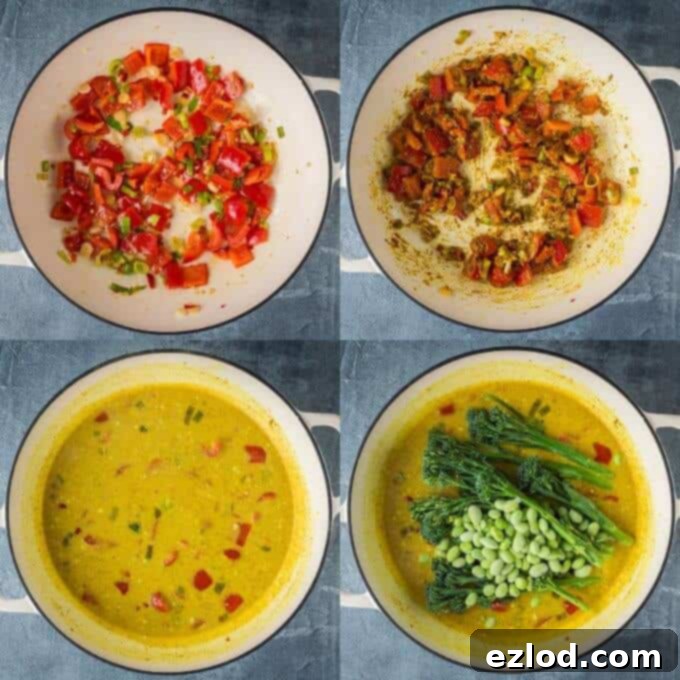
Preparing the Crispy Tofu
While your curry simmers, prepare the tofu. In a small bowl, combine one tablespoon of cornflour (also known as cornstarch) with a pinch of salt. Add your diced firm tofu and gently toss until each piece is evenly coated. This cornflour coating is optional but highly recommended. It creates a thin, crispy crust on the tofu when fried, adding a wonderful textural contrast to the soft vegetables and creamy sauce. If you prefer softer tofu or want to skip this step, the curry will still be delicious.
Heat the remaining tablespoon of olive oil in a separate frying pan over medium heat. Once hot, add the cornflour-coated tofu in a single layer, ensuring not to overcrowd the pan. Cook the tofu, turning it every now and again with tongs or a spatula, until it turns beautifully golden and crispy on all sides. This process usually takes about 5-8 minutes. The crispy texture of the tofu provides a delightful bite that elevates the entire dish.
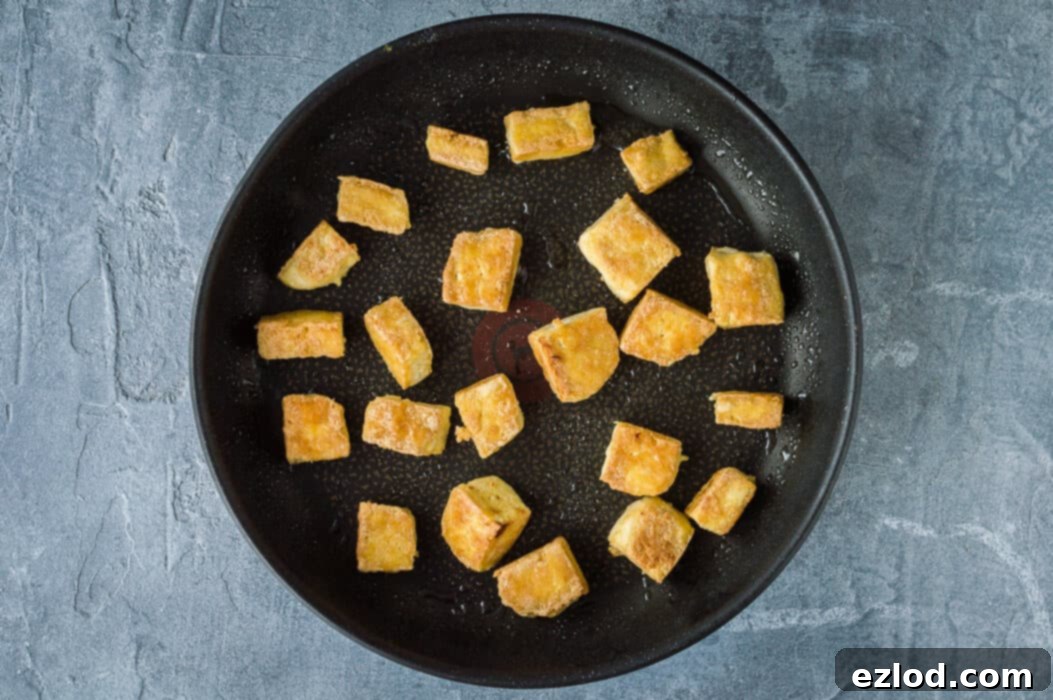
Bringing It All Together
Once the tofu is perfectly golden and crispy, gently stir it into the simmering curry. Give it a moment to absorb some of the aromatic sauce. Serve your glorious vegan lemongrass and coconut curry immediately with a generous helping of fluffy cooked rice. The combination of the creamy, spicy sauce, tender vegetables, and crispy tofu over warm rice is truly a delight for the senses. Garnish with a sprinkle of fresh coriander or a squeeze of lime juice for an extra burst of flavour if desired.
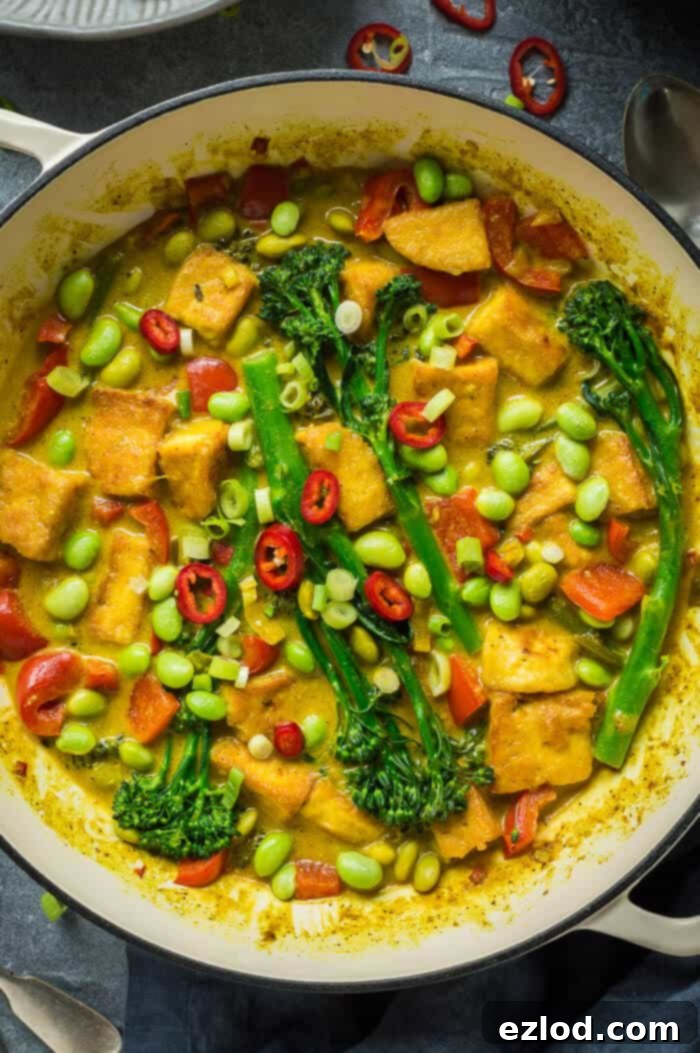
More Quick Vegan Meals:
- Lentil, vegetable and butter bean chilli
- Vegan corn fritters
- Chickpea, sweet potato and spinach curry
- Peanut tofu stir fry
- One pot mushroom pasta
- Spiced black beans and callaloo with coconut rice and plantain
If you tried this recipe why not tag @domestic_gothess on Instagram and hashtag it #domesticgothess
*All images and content on Domestic Gothess are copyright protected. If you want to share this recipe then please do so by using the share buttons provided. Do not screenshot or post the recipe or content in full.*

Print
Easy Lemongrass And Coconut Curry (Vegan)
Ingredients
- 2 Tbsp olive oil divided
- 2 cloves garlic crushed (or 1 tsp garlic paste from a jar)
- 2 spring onions (scallions) thinly sliced
- 1 red bell pepper sliced
- 1 red chilli finely chopped (or 1 tsp chilli paste from a jar)
- 2 tsp lemongrass paste (from a jar)
- 2 tsp ginger paste (from a jar) (OR a 1 inch piece fresh ginger, grated)
- 2 tsp garam masala
- 1 tsp turmeric
- 400 ml (14oz) tin coconut milk (either full fat or light is fine)
- 1 vegetable stock cube
- 120 g (4oz) tenderstem broccoli
- 80 g (3oz) frozen edamame
- 280 g (10oz) firm tofu diced
- 1 Tbsp cornflour (cornstarch) (optional)
- salt and pepper
- cooked rice to serve
Instructions
-
Heat 1 Tbsp of the olive oil in a large pan and add the crushed garlic, sliced spring onions, red bell pepper, and finely chopped red chilli. Fry gently for about five minutes until the vegetables are softened. (If using jarred garlic and chilli pastes, add them in the next step instead).
-
Add the lemongrass and ginger pastes (along with jarred garlic and chilli if you’re using them), garam masala, and turmeric. Fry for another minute, stirring constantly, until fragrant.
-
Pour in the coconut milk (from a tin, not the drinking kind) and crumble in the vegetable stock cube. Stir thoroughly and bring the sauce up to a gentle simmer.
-
Add the tenderstem broccoli and frozen edamame. Simmer for about 10 minutes, or until the broccoli is tender-crisp. Taste and season generously to your liking with salt and pepper.
-
While the curry is cooking, prepare the tofu. Place the cornflour in a bowl with a little salt. Add the diced firm tofu and toss gently to coat evenly. (This cornflour coating is optional for crispier tofu).
-
Heat the remaining 1 Tbsp olive oil in a separate frying pan. Add the coated tofu and cook over a medium heat, turning every now and again, until it’s golden and crispy on all sides.
-
Stir the crispy tofu into the finished curry and serve immediately with fluffy cooked rice.
Notes
Tips for a Perfect Lemongrass Coconut Curry Every Time
Achieving curry perfection is all about understanding the nuances of the ingredients and techniques. Here are some additional tips to help you master this vegan lemongrass and coconut curry and make it truly your own:
Enhancing the Aromatic Profile
- Fresh vs. Paste: While jarred pastes are excellent for convenience, if you have fresh lemongrass and ginger available, by all means, use them! For fresh lemongrass, trim the dry ends, remove the tough outer layers, and finely mince the tender inner stalk. For ginger, simply peel and finely grate. The fresh versions will offer a slightly brighter, more pungent aroma.
- Bloomin’ Spices: Don’t rush the step where you fry the spices (garam masala and turmeric) in oil. This “blooming” process in hot oil releases their fat-soluble flavours, deepening their complexity and fragrance. Just be careful not to burn them!
Tofu Texture Mastery
- Pressing Tofu: For the crispiest tofu, consider pressing your firm or extra-firm tofu for at least 30 minutes (or up to an hour) before dicing and coating. This removes excess water, allowing the tofu to absorb more flavour and achieve a superior crispy texture.
- Cornflour is Key: The cornflour coating isn’t just for crispiness; it also helps prevent the tofu from sticking to the pan and gives it a lovely golden hue. Don’t skip it if you love that satisfying crunch!
Customizing Your Curry
- Vegetable Variations: This curry is incredibly versatile. Feel free to swap out or add other vegetables. Green beans, sugar snap peas, spinach (stirred in at the very end), carrots (sliced thinly for quick cooking), or even mushrooms would work wonderfully.
- Adjusting Spice Levels: If you love a spicier kick, add an extra red chilli or a pinch of red chilli flakes when you add the pastes. For a milder curry, reduce the amount of chilli or omit it entirely.
- Sweet and Sour Balance: A squeeze of fresh lime juice at the end can brighten the flavours, adding a lovely zesty note. A tiny dash of maple syrup or a pinch of sugar can also help balance the acidity if needed.
Meal Prep and Storage
- Make Ahead: This curry tastes even better the next day as the flavours have more time to meld. You can prepare the entire curry (minus the crispy tofu, which is best made fresh) and store it in an airtight container in the fridge for up to 3-4 days.
- Reheating: Gently reheat the curry on the stovetop over low heat, adding a splash of water or coconut milk if it seems too thick. If you have leftover crispy tofu, you can reheat it in a dry pan or an air fryer to regain some crispness before stirring into the hot curry.
- Freezing: The curry (without the tofu) freezes well for up to 2-3 months. Thaw overnight in the fridge and reheat as directed. Cook fresh tofu when ready to serve.
The Nutritional Benefits of this Vegan Curry
Beyond its incredible taste and ease of preparation, this vegan lemongrass coconut curry is a nutritional powerhouse. Each ingredient contributes to a meal that supports overall health and well-being:
- High Protein: As highlighted, the combination of tofu and edamame provides a complete protein profile essential for muscle repair, energy, and satiety, making it an excellent choice for plant-based diets.
- Rich in Vitamins & Minerals:
- Tofu: A good source of calcium, iron, magnesium, and selenium.
- Edamame: Packed with folate, vitamin K, iron, and fibre.
- Broccoli: An excellent source of Vitamin C, Vitamin K, and fibre, known for its antioxidant properties.
- Red Bell Pepper: Rich in Vitamin C and antioxidants.
- Healthy Fats: Coconut milk provides medium-chain triglycerides (MCTs), a type of fat that can be easily digested and used for energy.
- Fibre-Packed: The array of vegetables and legumes contribute significant dietary fibre, crucial for digestive health, blood sugar regulation, and prolonged fullness.
- Anti-inflammatory Spices: Turmeric, in particular, is celebrated for its potent anti-inflammatory and antioxidant compounds, such as curcumin.
This curry truly offers a balanced and nourishing meal, proving that healthy eating can be both simple and incredibly flavourful.
Frequently Asked Questions (FAQs)
Can I make this curry gluten-free?
Yes, absolutely! This recipe is naturally gluten-free. Just ensure that your vegetable stock cube and any jarred pastes you use (lemongrass, ginger, garlic, chilli) are certified gluten-free, as some brands may contain hidden gluten ingredients.
What kind of rice should I serve with this curry?
Jasmine rice or basmati rice are excellent choices, offering a fragrant and fluffy texture that complements the curry perfectly. Brown rice would also work for an added nutritional boost and nutty flavour.
Can I add more vegetables?
Certainly! This curry is very adaptable. Feel free to add quick-cooking vegetables like snap peas, baby corn, sliced carrots, or a handful of spinach (stirred in at the very end). Just ensure your pan is large enough to accommodate them without overcrowding.
Is it possible to make this curry spicier?
If you prefer a fiery kick, you can add an extra fresh red chilli (or a dash of chilli paste) at the beginning, or sprinkle in some red pepper flakes along with the other spices. A few drops of sriracha or another hot sauce can also be stirred in at the end.
How do I store leftovers?
Leftovers can be stored in an airtight container in the refrigerator for up to 3-4 days. For best results, it’s recommended to store the curry and crispy tofu separately if possible, and add the tofu just before serving after reheating the curry.
Recipe inspired by Gluten Free Cuppa Tea
